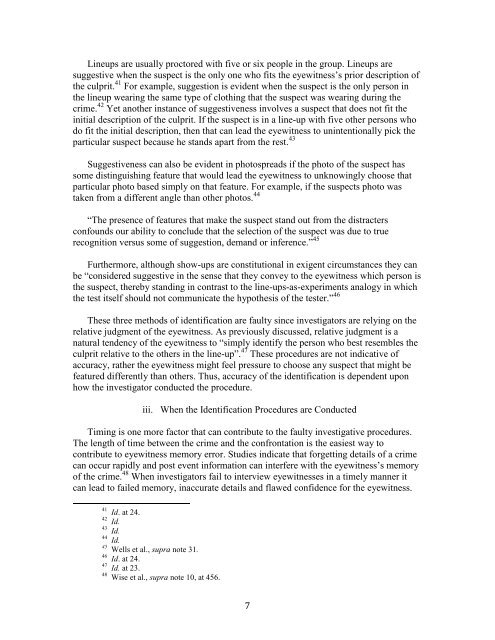dada_floridamisidentification_final - UDC Law Review
dada_floridamisidentification_final - UDC Law Review
dada_floridamisidentification_final - UDC Law Review
- No tags were found...
You also want an ePaper? Increase the reach of your titles
YUMPU automatically turns print PDFs into web optimized ePapers that Google loves.
Lineups are usually proctored with five or six people in the group. Lineups aresuggestive when the suspect is the only one who fits the eyewitness’s prior description ofthe culprit. 41 For example, suggestion is evident when the suspect is the only person inthe lineup wearing the same type of clothing that the suspect was wearing during thecrime. 42 Yet another instance of suggestiveness involves a suspect that does not fit theinitial description of the culprit. If the suspect is in a line-up with five other persons whodo fit the initial description, then that can lead the eyewitness to unintentionally pick theparticular suspect because he stands apart from the rest. 43Suggestiveness can also be evident in photospreads if the photo of the suspect hassome distinguishing feature that would lead the eyewitness to unknowingly choose thatparticular photo based simply on that feature. For example, if the suspects photo wastaken from a different angle than other photos. 44“The presence of features that make the suspect stand out from the distractersconfounds our ability to conclude that the selection of the suspect was due to truerecognition versus some of suggestion, demand or inference.” 45Furthermore, although show-ups are constitutional in exigent circumstances they canbe “considered suggestive in the sense that they convey to the eyewitness which person isthe suspect, thereby standing in contrast to the line-ups-as-experiments analogy in whichthe test itself should not communicate the hypothesis of the tester.” 46These three methods of identification are faulty since investigators are relying on therelative judgment of the eyewitness. As previously discussed, relative judgment is anatural tendency of the eyewitness to “simply identify the person who best resembles theculprit relative to the others in the line-up”. 47 These procedures are not indicative ofaccuracy, rather the eyewitness might feel pressure to choose any suspect that might befeatured differently than others. Thus, accuracy of the identification is dependent uponhow the investigator conducted the procedure.iii. When the Identification Procedures are ConductedTiming is one more factor that can contribute to the faulty investigative procedures.The length of time between the crime and the confrontation is the easiest way tocontribute to eyewitness memory error. Studies indicate that forgetting details of a crimecan occur rapidly and post event information can interfere with the eyewitness’s memoryof the crime. 48 When investigators fail to interview eyewitnesses in a timely manner itcan lead to failed memory, inaccurate details and flawed confidence for the eyewitness.41 Id. at 24.42 Id.43 Id.44 Id.45 Wells et al., supra note 31.46 Id. at 24.47 Id. at 23.48 Wise et al., supra note 10, at 456.7














